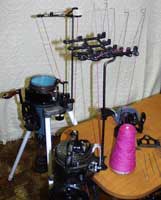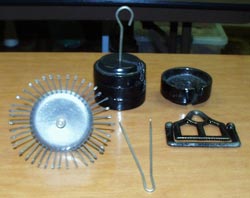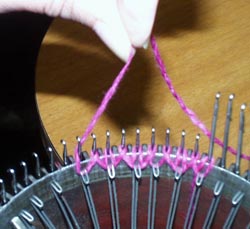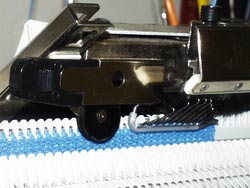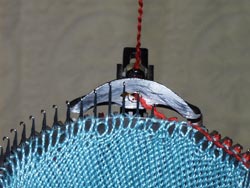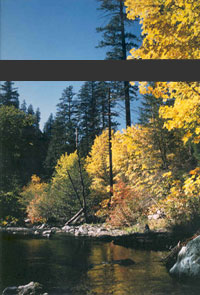Nothing New Under the Sun
A Look at the CSM: Circular Sock Machine Part 2
Written by Sharon Nani
Previously Published in “Machine Knitters Source”
Article # Twenty One
Issue: #101 (Mar/April 2001)
The adventure of learning about the circular sock knitting machines and at the same time gaining more understanding about the parts and functions of the flat bed’s of today is continued with this article. I discussed most of the parts within the Tension System Category in the last issue of MKS. Please refer to my article in MKS Issue 100 for this information. I will also follow the same method of differentiating between the terminology of the CSM’s and Flat Beds as I proceed.
NOTE:Click on all images to see an enlargement of the photo!Compare the Parts and Mechanical Functions of the CSM’s (Circular sSock Machines) and the Flat Bed Machines
Getting Started with the CSM
I will use comparison tables and pictures to aid in the explanations. I have the manuals for three different CSM: The Auto Knitter- Buffalo, New York, USA (also manufactured under the name of Ainslie and Harmony) The Legare –Montreal, Canada [pictures are from these two machines which are mine: Figure 1: Legare with ribber is in the front on the table, the Ainslie is behind it on a stand], and the Gearhart –Clearfield, Pa USA. The sock knitter part name will be given first in bold type, the flat bed terminology in parenthesis and italics. Each will be in this order of knitting machine brand where applicable Ex. CSM: Auto Knitter, Legare, Gearhart, (flat bed: Passap, Brothers, Studio, Artisan).
Refreshing back: the three categories of knitting machines parts are: 1. Tension System 2. Needle Beds, and 3. Locks / Carriages.
Referring back to Table 1, in Part I of this series, these are the parts of the Tension System that I will discuss next:
Comparative Part Names of Category 1: Setting Up for CSM’s and Flat Bed Knitting Machines.
Table 1: Tension System Terminology (taken from Instruction or Parts Manuals from my machines)
| Circular Sock Machines: Auto Knitter (Ainslie) Legare 47 Gearhart |
Double Bed Machines Passap DM80 Passap E6000 |
Holding Position Machines Brother/Knit King Studio Artisan |
| Buckle and Heel Weights – Buckle Brace and Weights | Cast on Combs and Weights | Cast on Combs and Weights |
| “Set Up”, “Set Up Basket”, “Set Up” | Cast on Combs and Weights | Cast on Combs and Weights |
| Heel Hook, Heel Hook, Hold Down and Heel Hook | Heel Grip | Claw Weight |
| Yarn Carrier – Yarn Carrier – Carrier Bar | Black, Blue, and Orange Strippers | Sinker Plates |
Once the knitting machine is threaded properly, there must be a way to get the yarn anchored unto the hooks of the latch needles and to keep them from falling out of those hooks as you knit the project of choice. All three types of parts from Table 1 help in this process. These parts also are considered part of the “Lock / Carriage Category”, but I will discuss them at this point as part of what controls the yarn from the Tension System Category. As with all knitting machines, a lot of the parts interlink their functions or serve more than one purpose. So let’s get on with it.
Circular Sock Machines Begin Knitting by Setting Up
The next big fact that must be considered is: Every knitting machine must have a means of holding or keeping the yarn in the hooks of the latch needles. There are two basic ways this is done. One is the ‘Pull Down” System, and the other one is the “Push Down” System. The Circular Sock Machines and the Holding Position Machines use the Pull Down System. Passap’s use the Push Down System. The second fact is that every knitting machine must have at least one way to begin or get the yarn on the hooks of the needles before you have to think about keeping them on the hooks. But the two tasks interplay. Let’s look at the method of ‘beginning’ first.
“The E Wrap” method is used on both the CSM’s and the Holding Position (HP) machines. CSM’s call the way to begin “Setting Up” and use a “Set up Basket” See Figure 1. The Set Up Basket is held in the inside of the cylinder in such a manner with the left hand, as you take the yarn, and going from right to left, wind the yarn around the hook of the cylinder needle in a clockwise fashion, as if you are writing the cursive letter E backwards, then bring the yarn down to catch the corresponding hook of the Set Up Basket. There are more cylinder needles than hooks, so you must occasionally, catch a hook twice. See Figure 2.
When you have wrapped all the needles and the yarn from each needle has also been hooked to the Set up, a weight is hung on this Set Up Basket. This ‘pulling down’ of the yarn, keeps a constant pressure on the stitches so that they should not ‘float out of the hooks of the cylinder needles as you knit. This process is called “Setting Up new stitches”. As you can see, it utilizes the ‘Pull Down Weight System”.
At this point, it was interesting to read in the Auto Knitter Instruction Manual, that the machine came in a special box that allowed the CSM to come assembled. It was already equipped with a ‘netting’ of yarn – a tube of knitting – attached to the needles. The new owner was cautioned to read the instructions carefully before proceeding and to begin knitting with the tube that was already there. It gave you the advantage to be able to practice on the machine before having to learn how to “Set Up”. The Legare Manual is only 8 pages that are written in French. I was fortunate to find Roxana Baechle on the ‘Sock Knitters List” who supplied me with the English interpretation of this manual. According to the manual, this machine came in a box disassembled. Therefore, one would have to start with the ‘Set Up’ on the Legare in order to begin knitting. My Gearhart Knitting Machine Manual was a 1942 edition. It had very good step-by-step instructions in it, which would have been generically applicable to any CSM. I assume that this is why this book was in my Ainslie Auto Knitter Box. A previous owner must have found this ‘newer manual’ useful. I have not personally worked on a Gearhart CSM.
Flat Bed Knitting Machines also use a Form of E Wrap Cast On

E Wrap Cast on for Flat Bed Knitting Machines that have the Holding Position ~ Single Bed Knitting Machines
The Holding Position Flat Bed Machines use this same “E Wrap” method in a slightly different manner. On the Flat Bed Machines, the needles are brought all the way forward, and going from left to right, the yarn is wound around each needle in a counter clockwise fashion as if you are writing the cursive letter E. See Figure 3 When you have wound yarn on all the needles you desire, the “ Cast on Comb” which has little hooks on it, is hooked to the e wrapped yarn. Then claw weights are hooked unto the cast on comb. This process is called “Casting On.“ Wow, do you see how these two processes are using the same “Pull Down System”. You see, there really is ‘Nothing New Under the Sun’. The Set Up Basket is circular to be used in the circular cylinder of the CSM. The Cast on Combs are rectangular to be used on the rectangular needle beds of the Flat Bed machines. Even though they have a different name and are a different shape, they serve the same purpose: to pull the yarn down: to create tension: to hold the stitches in the latch needles.
The Passap Knitting Machines use a different concept. They utilize the “Push Down System” of placing and keeping the yarn in the latch needles by the use of Strippers. These strippers are inserted into the locks. The locks move across the needle beds and the cams inside the locks force the latch needles to move upward to receive new yarn. When the needles are in a position to receive yarn, the strippers are in position to press, or push the yarn down under the hooks of these needles. The whole time the needle is moving, the stripper is applying pressure downward and against the yarn, therefore the stitches cannot float out of the latch hooks. Black Strippers have a bigger finger than the orange, pink, or blue strippers because they are used in ‘single bed’ knitting. This would be like knitting tubes on the cylinder needles on the CSM. See Figure 4: special note: I cast on the Back Bed, with Cast on Combs and lowered the front bed, disengaging the front lock to get a better view for photography of the function of the Black Strippers. This technique is also done in some advanced knitting.
Orange, pink, and blue strippers have finer fingers and are used when you are knitting on both the back and front beds. This would be like using the cylinder with the ribber dial on the CSM. When you are using two groups of needles coming from different directions, a smaller finger on the stripper is needed because there is less room for the finger to fit in between the two sets of needles. I am not discussing knitting techniques until the end of this series. So, I will only comment here that Flat Beds have automatic ways of Casting On with the help of Strippers and Cast On Combs.
CSM: Yarn Carriers ~ Flat Bed Knitting Machines: Strippers or Sinker Plates
The Yarn Carrier of the CSM also acts like a stripper in one way because it also must be close enough to the hooks of the needles to ‘place” the yarn in the hooks of the latch needles. The Yarn Carrier cannot touch the needles as it would bend or break them if it did. Also, you must assure that the hooks of the needles are open to receive the yarn. See Figure 5, look closely and you can actually see scratch marks on the surface of the Yarn Carrier, where the needles were perhaps ‘too close’. The big open stitches are from a ‘scrap cloth’ as another way of beginning. I will discuss that in a future issue. If the latches are not totally free so they can move easily as stitches are knit, they could be hit by the Yarn Carrier and broke off. Whereas, the needles on the Passap are opened by brushes within the lock mechanism therefore allowing the yarn to get into the hooks without physically making sure the latches are open.
The comparable part of the Holding Position Machines to the strippers and yarn carrier is the Sinker Plate. See Figure 8. See how the sinker plate at the right side of the knitting sits in front of the needles much like the Yarn Carrier of the CSM. Here too, the sinker plate serves the function of the yarn carrier by placing the yarn close to and into the hooks of the needles. The sinker plate also has brushes in it to open the latches of the needles to receive the yarn.
The Passap Machines have the advantage of being able to hang weights on their knitting like the Holding Position machines and the CSM’s. So they are the only domestic machines that can use both the push down and the pull down weight system. This helps them create the ‘unbalanced’ fabrics’ – which is a discussion for a different article.
The final thing to point out in this article is that once there is yarn in the hooks of the needles each of the machines has a method of keeping them there. The CSM’s attach a “Buckle with Weights” to the piece of knitting. When the knitting gets long enough, the Set Up Basket is removed and the Buckle and Weights take its place. See Figure 6. These weights continually pull down on the knit fabric. The Flat Bed machines all use the cast on combs and weights in the same fashion. And as already discussed, the Passap Flat Beds use the Strippers as well as Cast on Combs when desired.
The Heel Hook, Heel Grips, and Claw Weights are also used in projects that are not knitting evenly, such as the heel or toe of a sock where you are only knitting on the back of the sock while the front stitches are being held.. See Figures 7 and 8.
This finished the discussion on The Tension System category. Next issue we will begin to look at the terminologies, comparisons, and functions of the parts of the Needle Bed category.
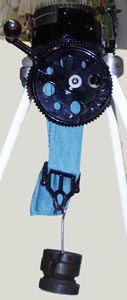 |
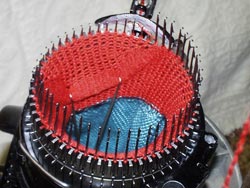 |
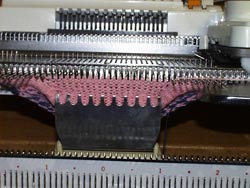 |
The Auto Knitter Hosiery Co., Inc. The Auto Knitter Instruction Book Eighteenth Edition. Buffalo, N. Y., 1922.
La Compagnie Legare Limitee. Manuel Du Tricoteur. 1200 Rue Amherst Montreal, P.Q. (no year found)
Superior Appliance & Pattern Co. Instruction Book for the Gearhart Knitting Machine. Clearfield, Pa, USA, 1942 Edition.
Visit us on facebook too ~ page is in development
